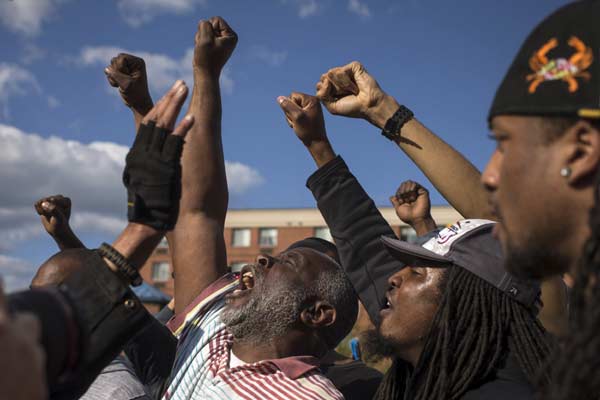Riot-hit Baltimore, an American city divided by income and opportunity
Updated: 2015-04-29 11:25
(Agencies)
|
|||||||||||
 |
|
Men shout "Freddie G" as they protest against the death of 25-year-old black man Freddie Gray who died in police custody in Baltimore, Maryland April 28, 2015. [Photo/Agencies] |
WASHINGTON - In the 1950's Baltimore was the sixth largest city in the United States with a peak population of nearly 950,000. Now the riot-hit metropolis ranks 26th on that measure and scores as one of the less equal American cities when measured by income and educational achievement.
Despite an economic recovery in the majority black East Coast city since the financial crisis, the gap between the haves and the have-nots is wide in a population that now numbers about 620,000.
In Baltimore, a household in the top 5 percent of income earners received $12.30 for each dollar earned by those in the bottom 20 percent in 2013, according to a 2014 analysis by Alan Berube and Natalie Holmes of the Brookings Institution, based on census data. By comparison, across the whole of the U.S., the top take in $9.30 for every dollar earned at the bottom.
Among 50 major U.S. cities, Baltimore ranked No. 12 in the inequality reading. Atlanta - which was one of the American cities hit hardest by the housing bust - was the most unequal, according to the Brookings study that covered 2007-2013.
The economic divide may have provided some of the tinder that led to looting and arson in the city on Monday night after the funeral for a 25-year-old black man who died on April 19 from a serious spinal cord injury, a week after he was arrested by police.
Growing income inequality has emerged as a key theme ahead of the 2016 presidential election with both Democrats and Republicans calling for the issue to be addressed. President Barack Obama has termed income inequality and the inability to move up the ladder as "the defining challenge of our time".
LACK OF MOBILITY
In a paper published last year, Raj Chetty of Harvard University and his co-authors found the Baltimore area ranked near the bottom of major U.S. cities in terms of mobility.
According to the study, someone born into the bottom fifth of the population in Baltimore stood 6.4 percent chance of making it to the top one fifth of the income strata. That compared with an 11 percent chance in Washington, D.C.
Related Stories
Obama says no excuse for Baltimore violence 2015-04-29 08:25
Riots erupt in Baltimore after funeral 2015-04-29 07:40
Baltimore erupts in riots after funeral of man who died in police custody 2015-04-28 23:59
Riot, looting prompt state of emergency, curfew in Baltimore 2015-04-28 09:52
Wake held in Baltimore for black man who died after arrest 2015-04-27 10:07
Today's Top News
Nepalis wait for quake help as death toll passes 4,000
61 suspects back home to be tried
PLA's Moscow debut confirmed
DPRK, Russia ink protocol after inter-governmental meeting
Belt and Road Initiative a boost to China, regional economy
China rescue team starts work in Nepal
At least 20 dead in Tibet following Nepal quake
Opinion: China leads in many high-speed rail aspects
Hot Topics
Lunar probe , China growth forecasts, Emission rules get tougher, China seen through 'colored lens', International board,
Editor's Picks

|

|

|

|

|

|






